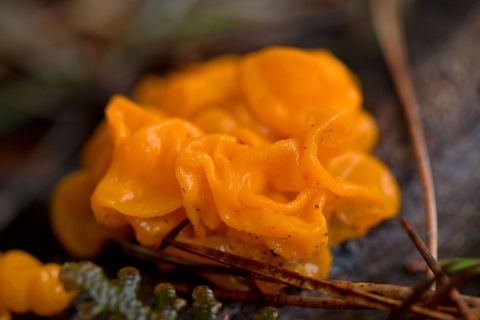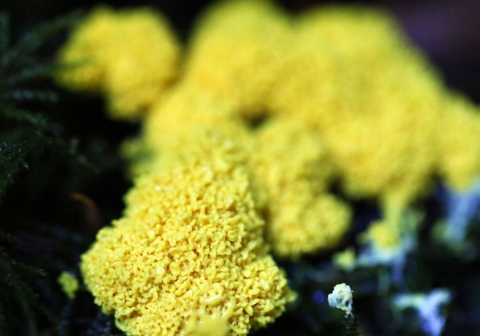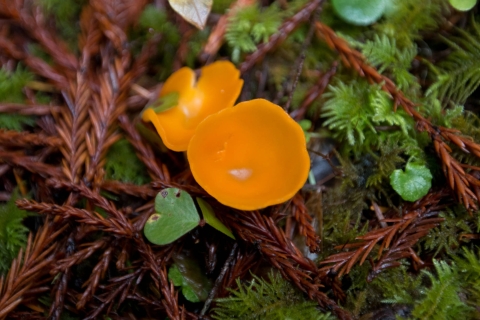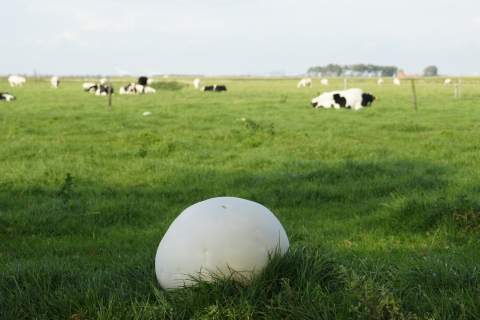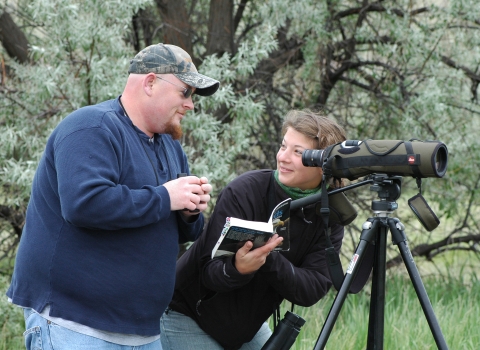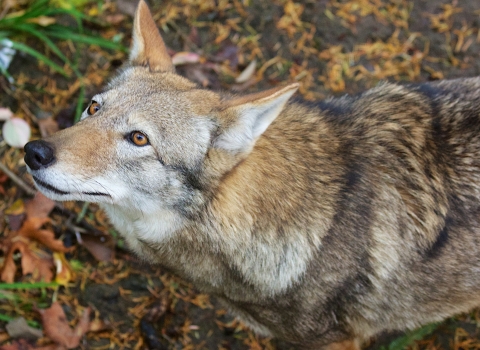Fungi are one of the most fascinating and diverse forms of life on our planet, but also one of the least studied. A study by mycologist Meredith Blackwell estimated that there are as many as 5 million species of fungi globally, but only a fraction have been described by scientists. While mycologists (fungi scientists) across the world are working to find and catalog these undiscovered species, some common fungi can be found in many different places, even your own backyard!
Witch's Butter (Tremella mesenterica)
This wrinkly fungus comes in many different shades of yellow and orange. It is often found growing on wood, whether it be a live tree, fallen log, or even a fence post. In the Middle Ages, this fungus was often found growing on wooden household fixtures like door frames and fence posts. People at the time believed this was a sign that your home had been cursed by a witch. The only way to lift the “curse” was to prick the fungus and drain the liquid from inside. Witch’s butter can be found on all continents except Antarctica.
Dog Vomit Slime Mold (Fuligo septica)
This fascinating find is technically not a fungus, but we want to show it off anyway! Slime molds are a type of protist, meaning that their nucleus is enclosed within a cellular membrane, but they are unrelated to other plants, fungi, or animals. For many years, scientists believed that slime molds were a type of fungi, but that thought was discarded with further scientific analysis. The dog vomit slime mold received its colorful name from its appearance similar to that of, well, dog vomit. In its early growth stages, the slime mold appears bright yellow in color and can grow very rapidly. A mature member of this species will appear drier and have a dusty orange color. The dog vomit slime mold, also known as the scrambled egg mold, is found almost worldwide and is commonly seen in areas with mulch, particularly after heavy rain.
Orange Peel Fungus (Aleuria aurantica)
You may think that someone left their orange peel on the ground, but this is actually a fungus! This deceptive fungus is often found in clusters in wooded areas. It is named for its distinct similarity to an orange peel. These bright orange spots in the forest can be found throughout North America, though it is primarily seen during the summer months.
Fly Agaric (Amanita muscaria)
As one of the most well-known fungus species in the media, the fly agaric brings to mind images of wildlife taking a rest, using the mushroom as a stool or hiding underneath its bright red top. However, the truth is far from picture-perfect. The fly agaric is toxic to humans and can cause severe illness if ingested. The typical red fly agaric is seen more in the western United States, while an orange-yellow variety might be seen in the eastern United states. These mushrooms are a friendly reminder that no matter how beautiful a mushroom may appear, it could be hiding a sickening secret!
Giant Puffball (Calvatia gigantea)
Giant puffballs are one of the most well-known species in the puffball family. They are the largest members of the puffball family as well, with some growing larger than a basketball! Puffballs get their name from the way they distribute their spores to reproduce. When a puffball reaches maturity, its skin will crack and release billions of spores into the surrounding area. These mushrooms often appear to be “resting” in both open and wooded areas, which leads many people to believe they are abandoned sports balls. Giant puffballs have been observed across the continental United States, but they seem to be more densely populated east of the Mississippi River.
Tips for finding and identifying fungi in your area:
Use local weather and habitat type to guide your search.
Season, recent weather, and habitat type may make a difference in what types of fungi you may find. Many fungi feed on decomposing matter, so fallen logs are usually a hot spot for one or more different kinds of fungi. Fungi also enjoy moist areas, so searching one or two days after a heavy rain may produce different results than going during a dry period.
Use field guides to help you identify a fungus.
Field guides come in many forms! You may prefer to use a book or pamphlet provided by a trusted source like a local or national park. Others may use field identification cell phone apps like iNaturalist to get an initial identification of a fungus.
Never eat a mushroom found in the wild if you are not an expert.
Many mushrooms contain toxins that can cause severe illness or even death if consumed. According to a 2021 publication from the Center for Disease Control, in 2016 alone, over 1,300 emergency room visits and 100 hospitalizations were the result of accidental mushroom poisoning.


